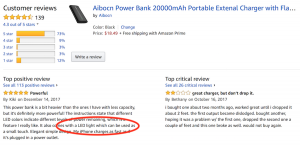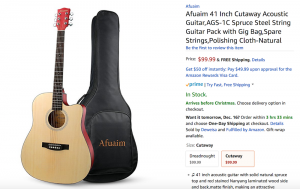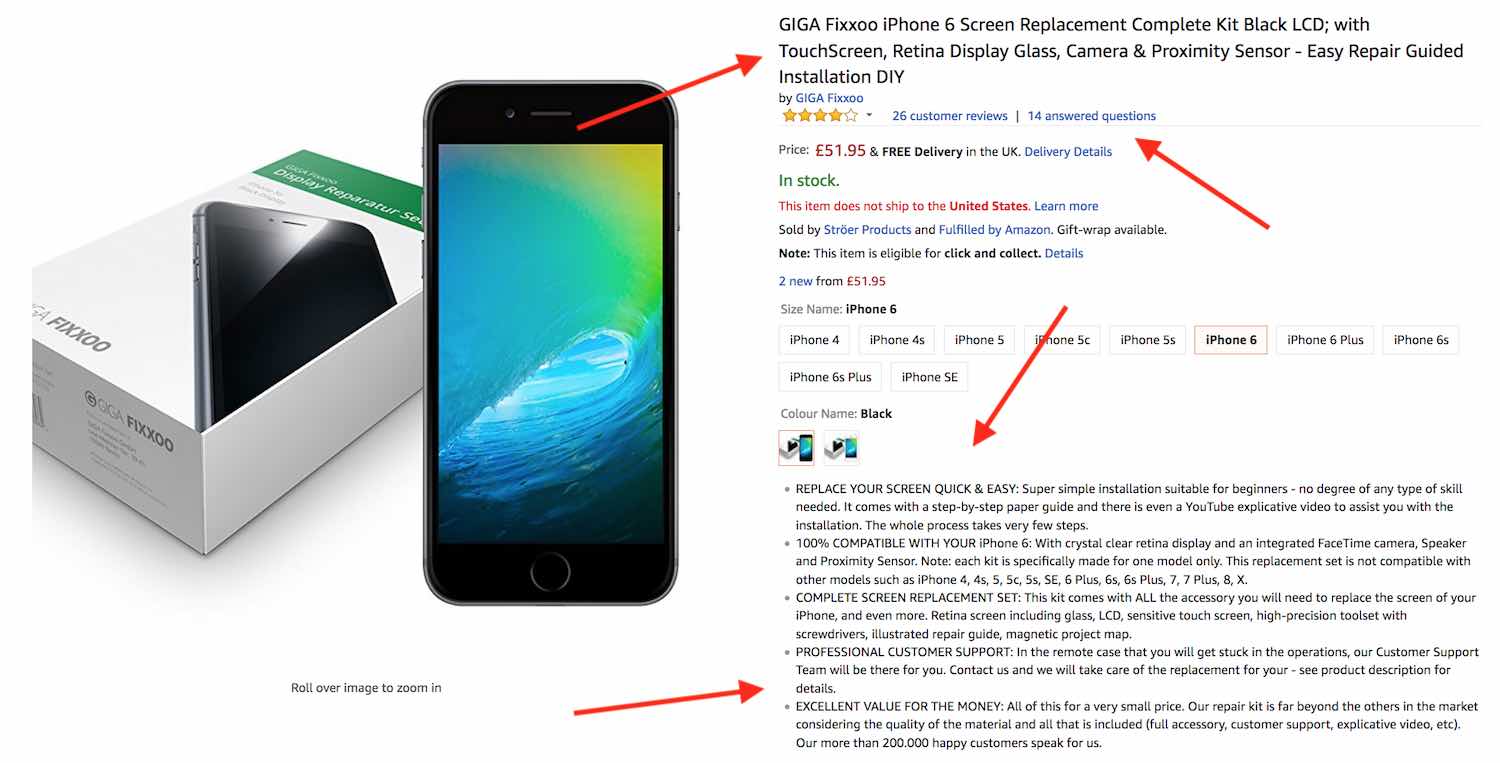Use the code DN100 to save $100 on each ticket of The Global Source CrossBorder e-Commerce Summit 2018 in Hong Kong. This is a great opportunity to meet the suppliers and create valuable sourcing relationships. Buy 2 or more tickets to save an additional $100 per ticket. Buy your ticket by clicking here.


1. Keep It Simple
 It might not come easy to the verbose or lover of words, but one of the keys when writing an Amazon listing is to err on the side of simplicity. In other words, keep your sentences short and your words simple. It might be tempting to explain the technical ins-and-outs of your product (and there may be times when it’s needed), but for the most part, the majority of products do not need those details. Remember that the listing needs to be easily understood by all people, no matter their age or location.
It might not come easy to the verbose or lover of words, but one of the keys when writing an Amazon listing is to err on the side of simplicity. In other words, keep your sentences short and your words simple. It might be tempting to explain the technical ins-and-outs of your product (and there may be times when it’s needed), but for the most part, the majority of products do not need those details. Remember that the listing needs to be easily understood by all people, no matter their age or location.
2. Write With Your Unique Voice
 Let’s be real. The sad truth about Amazon listings it that the majority of them are more or less the same. After all, how many ways are there to write about a speaker in an engaging manner that hasn’t been done before? Thankfully there is a way to stand out from your competitors’ bland listings – make your writing count. Make it count by adding your brand’s unique voice, or by positioning the product from an out-of-the-box perspective. Do that and your listing will come across as original, and dare we say, interesting. Suddenly you will stand out. Not only that but by adding your voice you can unify the tone of the listing with that of your website, social media, and other channels.
Let’s be real. The sad truth about Amazon listings it that the majority of them are more or less the same. After all, how many ways are there to write about a speaker in an engaging manner that hasn’t been done before? Thankfully there is a way to stand out from your competitors’ bland listings – make your writing count. Make it count by adding your brand’s unique voice, or by positioning the product from an out-of-the-box perspective. Do that and your listing will come across as original, and dare we say, interesting. Suddenly you will stand out. Not only that but by adding your voice you can unify the tone of the listing with that of your website, social media, and other channels.
3. Review the Reviews
 We opened this article with a common situation where many of our customers (and even ourselves) open a listing, skip the description, and go straight to the reviews. As a seller, all that work optimizing the content might seem for nothing. Thankfully you can turn the habits of your customers around and make it benefit you. After accruing a number of reviews – both good and bad – modify the content according to that feedback. If customers are consistently praising a feature that barely got a mention in the bullet points or description, edit those sections to highlight this feature. The reviews mention this feature over the others for a reason and by letting other customers know about it, you can capture those fence-sitters who are looking for a reason to click buy.
You can even check the competitions’ reviews, find out what issues their customers have with their product, then modify your content to make up for your competitors weakness and appeal to their dissatisfied customers. That’s a big win and one of our secrets that we use to take your listing and convert it into a sale.
Extra tip: get even more information out of your (or your competitors’) Q&A section!
We opened this article with a common situation where many of our customers (and even ourselves) open a listing, skip the description, and go straight to the reviews. As a seller, all that work optimizing the content might seem for nothing. Thankfully you can turn the habits of your customers around and make it benefit you. After accruing a number of reviews – both good and bad – modify the content according to that feedback. If customers are consistently praising a feature that barely got a mention in the bullet points or description, edit those sections to highlight this feature. The reviews mention this feature over the others for a reason and by letting other customers know about it, you can capture those fence-sitters who are looking for a reason to click buy.
You can even check the competitions’ reviews, find out what issues their customers have with their product, then modify your content to make up for your competitors weakness and appeal to their dissatisfied customers. That’s a big win and one of our secrets that we use to take your listing and convert it into a sale.
Extra tip: get even more information out of your (or your competitors’) Q&A section!
4. Use The Best Keywords
 Getting your product visible to potential buyers is of prime importance, which is why you need to select the right keywords for maximum visibility. Once you have the right keywords, you can enter them in your listing and in your title. But how do you know which keywords to use and how do you get them without spending hundreds? The answer is simple and it’s free. Firstly you have Amazon’s search bar. Type in a keyword and wait to see all of Amazon’s results. You will suddenly see the most common searches people have made using that keyword.
But if that’s not enough then there’s Google’s Keyword Planner. Type in a word or phrase and get the estimated amount of times that word is searched. The best part is that you can also view long tail keywords for unconventional keywords or phrases that people have used in relation to your product category. Use them to get the customers your competitors with more standard keywords are missing out on.
Speaking of your competitors, another way to gather new keywords is to view the competition and see what words feature in their listings. Are they using anything you are not using? Grab it. You’ll be happy you did.
Getting your product visible to potential buyers is of prime importance, which is why you need to select the right keywords for maximum visibility. Once you have the right keywords, you can enter them in your listing and in your title. But how do you know which keywords to use and how do you get them without spending hundreds? The answer is simple and it’s free. Firstly you have Amazon’s search bar. Type in a keyword and wait to see all of Amazon’s results. You will suddenly see the most common searches people have made using that keyword.
But if that’s not enough then there’s Google’s Keyword Planner. Type in a word or phrase and get the estimated amount of times that word is searched. The best part is that you can also view long tail keywords for unconventional keywords or phrases that people have used in relation to your product category. Use them to get the customers your competitors with more standard keywords are missing out on.
Speaking of your competitors, another way to gather new keywords is to view the competition and see what words feature in their listings. Are they using anything you are not using? Grab it. You’ll be happy you did.
5. Don’t Keyword-Stuff Your Listing
 Searching for a product on Amazon is simple: type in keywords related to your product, then receive the appropriate result in response. But sometimes, customers may not search the exact keyword related to your product, which is why you can add additional keywords to help people find you. However the ability to add a virtually endless amount of keywords causes one problem. The listings become messy and ugly, with words arranged together in grammatically incorrect ways. The end result is a listing that provides the customer with little-to-no understanding of the product. Sure Amazon’s search algorithm loves it but do the customers when they have no idea what a product can do?
Here’s what you should do instead: Write an awesome title or description, but instead of using every possible keyword, just use your strongest keywords in a grammatically correct way. Not only do you avoid the mess that comes with keyword stuffing, but also you get all the benefits of using multiple keywords so customers can find you while also keeping the listing looking professional. Besides, you can also add those extra keywords in the backend so people can still locate you.
Searching for a product on Amazon is simple: type in keywords related to your product, then receive the appropriate result in response. But sometimes, customers may not search the exact keyword related to your product, which is why you can add additional keywords to help people find you. However the ability to add a virtually endless amount of keywords causes one problem. The listings become messy and ugly, with words arranged together in grammatically incorrect ways. The end result is a listing that provides the customer with little-to-no understanding of the product. Sure Amazon’s search algorithm loves it but do the customers when they have no idea what a product can do?
Here’s what you should do instead: Write an awesome title or description, but instead of using every possible keyword, just use your strongest keywords in a grammatically correct way. Not only do you avoid the mess that comes with keyword stuffing, but also you get all the benefits of using multiple keywords so customers can find you while also keeping the listing looking professional. Besides, you can also add those extra keywords in the backend so people can still locate you.
6. Maximize The Bullet Points
 Contrary to what you can see, the bullet points matter. Yes, those five magnificent points that sit below the title are just as important as anything else on the listing, which is why they need to be filled out for maximum impact. For starters, start the bullet point with a summary of a key feature for those flicking through the listing and who do not have time to read everything. Then follow that up with a few more details, or list a benefit, or mention a secondary feature.
You can also use this space to let customers learn a little bit more about your company or tell them what else is included when they buy your product. The point is, Amazon gives you five spots to let customers know about your products so make the most of the space instead of not providing enough details or worse, leaving it blank!
Contrary to what you can see, the bullet points matter. Yes, those five magnificent points that sit below the title are just as important as anything else on the listing, which is why they need to be filled out for maximum impact. For starters, start the bullet point with a summary of a key feature for those flicking through the listing and who do not have time to read everything. Then follow that up with a few more details, or list a benefit, or mention a secondary feature.
You can also use this space to let customers learn a little bit more about your company or tell them what else is included when they buy your product. The point is, Amazon gives you five spots to let customers know about your products so make the most of the space instead of not providing enough details or worse, leaving it blank!
7. Structure Your Writing
 As much as you love whatever it is that you are selling, your audience may not be at that stage yet. Part of getting them there is letting them know exactly why they should buy your product. One way to do this when writing your listing is to structure it with an old favourite: Feature > Benefit. It’s simple. List one of your product’s features, and then follow it up with how it benefits the audience.
Here’s an example using a guitar:
As much as you love whatever it is that you are selling, your audience may not be at that stage yet. Part of getting them there is letting them know exactly why they should buy your product. One way to do this when writing your listing is to structure it with an old favourite: Feature > Benefit. It’s simple. List one of your product’s features, and then follow it up with how it benefits the audience.
Here’s an example using a guitar:
- Six nylon strings and a hollow body design (the features) play a rich, sonorous sound (the benefit).
- Six nylon strings and a hollow body design (the features) enable you to play a rich, sonorous sound that will turn heads and get numbers (the benefits).
8. Now Throw It Out
 Look, we love the Feature > Benefit structure, but you don’t need to be beholden to it. In fact you can play around with the writing for maximum effect. For example, you can switch it: Benefit > Feature.
Look, we love the Feature > Benefit structure, but you don’t need to be beholden to it. In fact you can play around with the writing for maximum effect. For example, you can switch it: Benefit > Feature.
- Enjoy uninterrupted sleep and wake up feeling well rested (benefit) with a memory foam mattress that automatically matches the contours of your body (feature).
- Our notepads are the first choice for professionals and students (the audience) looking for an easy and portable solution to keep files organized (best use).
9. Every Section Is Important
 It’s not just the bullet points that need to be filled out; all sections are equally as important and need to be completed. We understand that it’s easy to overlook a part or think it doesn’t matter. After all, why add a description when you have the bullet points? Or why bother with the A+ visual content when you already have that information presented elsewhere? The thing is, all of it is important. Remember that thing we mentioned before called professionalism? It’s part of creating a cohesive experience for your customers. Don’t forget that maximizing the available space also allows you to provide extra details such as additional technical information or aspects about your customer service.
It’s not just the bullet points that need to be filled out; all sections are equally as important and need to be completed. We understand that it’s easy to overlook a part or think it doesn’t matter. After all, why add a description when you have the bullet points? Or why bother with the A+ visual content when you already have that information presented elsewhere? The thing is, all of it is important. Remember that thing we mentioned before called professionalism? It’s part of creating a cohesive experience for your customers. Don’t forget that maximizing the available space also allows you to provide extra details such as additional technical information or aspects about your customer service.
10. Learn From The Competition
 To be the best, you need to learn from the rest which is why, for optimized Amazon listing content, we suggest you head on over and see how your competitors listings look. Checking their content can help you structure yours. Are they using HTML to bold product features? Do they use the description to address a common problem customers are having? Is there content highlighting many features or only one?
Find out what works for them and compare it your content. If they are doing something better, then use that too. If they are doing something that could complement your brand, adopt it. Remember that some of the biggest sellers on Amazon are there for a reason, and finding out what makes their content work for them is something that you can turn around and make work for you.
To be the best, you need to learn from the rest which is why, for optimized Amazon listing content, we suggest you head on over and see how your competitors listings look. Checking their content can help you structure yours. Are they using HTML to bold product features? Do they use the description to address a common problem customers are having? Is there content highlighting many features or only one?
Find out what works for them and compare it your content. If they are doing something better, then use that too. If they are doing something that could complement your brand, adopt it. Remember that some of the biggest sellers on Amazon are there for a reason, and finding out what makes their content work for them is something that you can turn around and make work for you.
11. Be A Pro
 As you can tell by the fact that we think keyword packed listings look messy and win you no points with your customers, professionalism is a big deal to us and it should be for you. Having a professional listing is what adds legitimacy to your product and your brand. It doesn’t give the buyer on the fence the chance to write you off. So how do you make your wording as professional as possible? It’s easy just think back to school. The same rules apply when writing a listing as they did when submitting an assignment: proofread for spelling errors, fix poor grammar, and edit expressions that don’t make sense. Don’t be afraid to dust of your old English textbooks or to buy a grammar book if you need it.
As you can tell by the fact that we think keyword packed listings look messy and win you no points with your customers, professionalism is a big deal to us and it should be for you. Having a professional listing is what adds legitimacy to your product and your brand. It doesn’t give the buyer on the fence the chance to write you off. So how do you make your wording as professional as possible? It’s easy just think back to school. The same rules apply when writing a listing as they did when submitting an assignment: proofread for spelling errors, fix poor grammar, and edit expressions that don’t make sense. Don’t be afraid to dust of your old English textbooks or to buy a grammar book if you need it.





